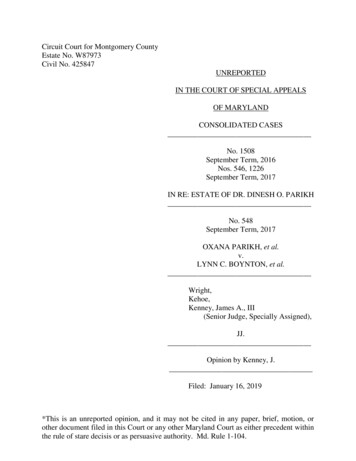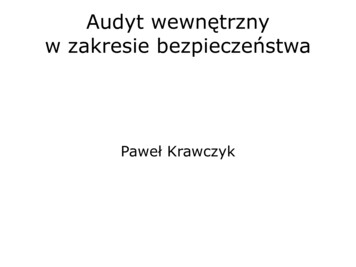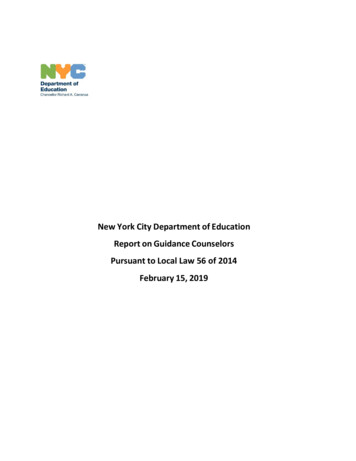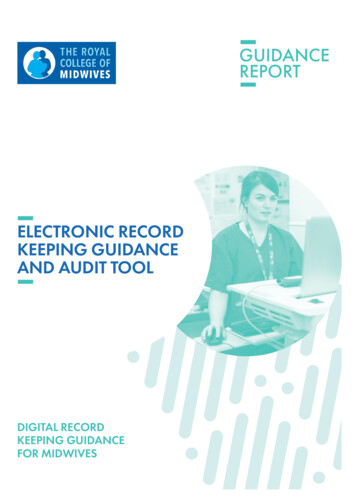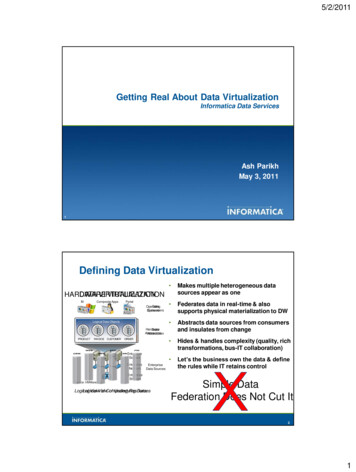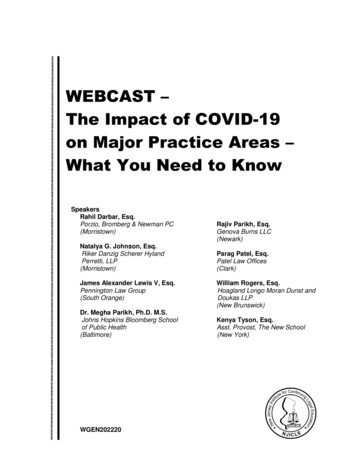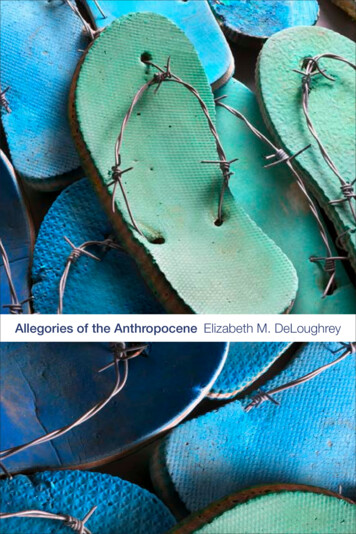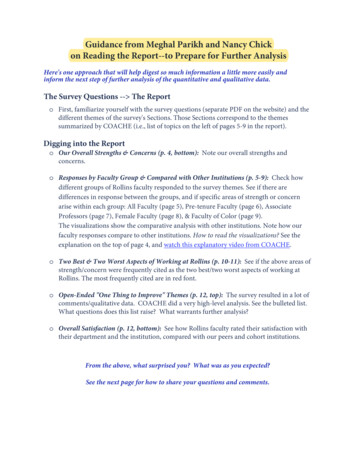
Transcription
Guidance from Meghal Parikh and Nancy Chickon Reading the Report--to Prepare for Further AnalysisHere's one approach that will help digest so much information a little more easily andinform the next step of further analysis of the quantitative and qualitative data.The Survey Questions -- The Reporto First, familiarize yourself with the survey questions (separate PDF on the website) and thedifferent themes of the survey's Sections. Those Sections correspond to the themessummarized by COACHE (i.e., list of topics on the left of pages 5-9 in the report).Digging into the Reporto Our Overall Strengths & Concerns (p. 4, bottom): Note our overall strengths andconcerns.o Responses by Faculty Group & Compared with Other Institutions (p. 5-9): Check howdifferent groups of Rollins faculty responded to the survey themes. See if there aredifferences in response between the groups, and if specific areas of strength or concernarise within each group: All Faculty (page 5), Pre-tenure Faculty (page 6), AssociateProfessors (page 7), Female Faculty (page 8), & Faculty of Color (page 9).The visualizations show the comparative analysis with other institutions. Note how ourfaculty responses compare to other institutions. How to read the visualizations? See theexplanation on the top of page 4, and watch this explanatory video from COACHE.o Two Best & Two Worst Aspects of Working at Rollins (p. 10-11): See if the above areas ofstrength/concern were frequently cited as the two best/two worst aspects of working atRollins. The most frequently cited are in red font.o Open-Ended "One Thing to Improve" Themes (p. 12, top): The survey resulted in a lot ofcomments/qualitative data. COACHE did a very high-level analysis. See the bulleted list.What questions does this list raise? What warrants further analysis?o Overall Satisfaction (p. 12, bottom): See how Rollins faculty rated their satisfaction withtheir department and the institution, compared with our peers and cohort institutions.From the above, what surprised you? What was as you expected?See the next page for how to share your questions and comments.
Selected InstitutionsYou selected 5 institutions as peers againstwhom to assess your COACHE Surveyresults. The results at these institutions areincluded throughout this report in theaggregate or, when cited individually, inrandom order. Agnes Scott College (2020) Davidson College (2020) Gettysburg College (2020) Kenyon College (2018) Muhlenberg College (2020)Cohort InstitutionsFaculty from the following 27 institutionscomprise the comparison cohort of liberalarts colleges for this 2020 Chief AcademicOfficer Report. Agnes Scott College (2020) Amherst College (2020) Babson College (2019) Barnard College (2017) Bates College (2018) Centre College (2020) Colgate University (2018) Davidson College (2020) Gettysburg College (2020) Hamilton College (2018) Harvey Mudd College (2020) Juniata College (2020)COACHE Statement about Surveying During COVID Kenyon College (2018)“COACHE conducted an analysis of response rates and Lafayette College (2020)patterns to determine whether there were any practical Manhattan College (2019)differences between response patterns of faculty who Mills College (2020)completed the survey prior to the COVID-19 Mount Holyoke College (2020)disruptions and those faculty who responded later in the Muhlenberg College (2020)survey administration period. Their analysis concluded Occidental College (2018)that the impact on the survey report is likely negligible.” Ohio Wesleyan University (2019) Saint Mary's College of Maryland (2017) The University of the South (2018) University of North Carolina-Asheville (2018) Ursinus College (2020) Washington and Lee University (2020) Wellesley College (2020) Wofford College (2020)
Rollins College 2019-20Faculty Job Satisfaction Survey Report
Acknowledgements:Many people and organizations are responsible for making the COACHE project possible. We would especially like tothank the following:The Ford FoundationThe Atlantic PhilanthropiesHarvard Graduate School of EducationAll of our partner institutionsReproduction:No part of this report or its appendices may be reproduced in any form without written permission from the Collaborativeon Academic Careers in Higher Education (COACHE), such as that given in a participation agreement signed byrepresentatives of participating institutions and COACHE. Any reproduction of the report material must include a creditline.Contact information:The Collaborative on Academic Careers in Higher Education (COACHE)Harvard Graduate School of Education8 Story Street, 5th FloorCambridge, MA 02138Email: coache@gse.harvard.eduURL: https://coache.gse.harvard.eduVoice: 617-495-5285Fax: 617-496-9350Copyright 2020 by The President and Fellows of Harvard College. All Rights Reserved.
ContentsIntroduction2ResultsSelected Comparison Institutions and Response Rates3COACHE Benchmarks: Strengths and Concerns4Comparative AnalysisAll Faculty5Pre-tenure Faculty6Associate Professors7Female Faculty8Faculty of Color9Global ConsiderationsBest Aspects10Worst Aspects11Other Perspectives: In Your Faculty's Own Words12Other Perspectives: The Department and Institution as a Place to Work12Next Steps: Distributed Leadership13Notes and Guided Discussion Questions14
IntroductionIntroductionYou are holding in your hands a preview of the COACHEChief Academic Officer Report. The CAO Report data anddesign are the culmination of our work since 2003 withfaculty focus groups, two pilot studies (for pre-tenure andtenured faculty), and ongoing dialog with academic leadersat our partner institutions.This preview is just a glimpse of what lies within yourCAO Report—a beginning, not the end. The digital filesthat follow this preview contain item-level analysis,faculty's qualitative opinions coded by survey theme,results disaggregated by school/college and discipline, andmore tools for understanding the conditions faculty need inorder to do their best work.While there are many approaches to report design, ourchoices at COACHE leverage our comparative data to helpyou, your leadership team, and your faculty move moreswiftly from survey results into dissemination, engagementand action.You are about to discover that many faculty concerns canbe dealt with immediately and inexpensively, while otherspresent themselves as opportunities for broad involvementin designing collaborative solutions.To the uninitiated, the CAO Report can be daunting.However, just a few minutes spent with the Results at aGlance and Benchmark Dashboard will unlock the broadthemes of your survey results and the areas deserving ofimmediate scrutiny.The questions at the end of this preview should help you getthis process of inquiry underway. Yet, at COACHE, wehave learned that the most important analysis has yet tooccur. Analysis is a social process of engagement with yourcolleagues and—most importantly—your faculty. TheCOACHE partners who succeed do so by inviting faculty tobe agents of institutional improvement.Your faculty's strengths and concerns will be revealed, layerby layer, as you follow the green, grey, and red colors ofyour CAO Report. These colors illustrate your faculty'sattitudes relative to peers of your own choosing and to alarger, labor-market cohort (e.g., women to women,associate professor to associate professor). The yellow andorange colors will identify gaps between groups within yourown institution (e.g., women and men, associate and fullprofessors).As you embark upon the next steps of "collectivesensemaking" and action, we have many examples to share.Your research-practice partnership with COACHEcontinues beyond this report delivery for many months ofadvice and networking. Allow us to develop your capacityfor evidence-driven leadership in the academy.2
Comparison Institutions and Response RatesYour Cohort and PeersBased on the number of Rollins College faculty and otherorganizational characteristics, your comparison "cohort"includes 27 COACHE partners who identify as generallysimilar. The complete list is available in the CAO Report'sappendices. You selected five comparison institutions –"peers" in the report – to represent those most similar toyou in the faculty labor market. They are listed at the right.Agnes Scott College (2020)Davidson College (2020)Gettysburg College (2020)Kenyon College (2018)Muhlenberg College (2020)Response RatesYour report summarizes the findings from 62% of youreligible faculty. Given an average survey completion timeof 22 minutes, this report constitutes approximately 51hours of your faculty’s time and, more importantly, theircandor. Your response rate is lower than your peers byapproximately 2.8 percentage points.Differences in rates of response between demographicgroups matter, as well. The table below summarizesresponse rates by tenure status, rank, gender, and race. Asyou read this preview and the complete CAO Report, keepin mind how large or small these subgroups’ representationis among your survey responses.Response Rates12YouPeersCohortAll %Non-tenure Track61%57%52%Full Professor63%61%61%Associate 2%66%64%Faculty of presented Minorities59%64%57%"Faculty of color" are, for the purposes of this report, those individuals not categorized as White, non-Hispanic."Underrepresented minorities" are individuals who identify as neither White, non-Hispanic nor Asian/Asian-American.3
COACHE Benchmarks: Strengths and ConcernsUnderstanding the COACHE BenchmarksThe following five pages offer a view of your faculty from10,000 feet. Each survey theme is summarized by a“Benchmark,” the mean of several five-point Likert-scalesurvey questions that share a common theme. A Benchmarkscore provides a general sense of how faculty feel about aparticular aspect of their work/life at your institution; yourCAO Report delivers results for Benchmarks and forspecific survey items.In this preview, we compare your Benchmark scores, shownas diamonds, to the scores of other COACHE partners,represented as horizontal lines. Green lines represent thetop 30 percent of institutional means, red lines represent thebottom 30 percent, and grey lines represent institutions inthe middle 40 percent. The circles locate the fiveinstitutions your team selected as most nearly competingwith yours (or resembling yours) in the market for faculty.The black line represents your prior results (if applicable).Your Strengths and ConcernsAreas of strength (all faculty combined)As shorthand, COACHE defines as an "area of strength"any Benchmark where your institution scores first orsecond among your selected comparison group and in thetop 30 percent (the green section) of the cohort.Conversely, an "area of concern" is where your facultyrating of a Benchmark falls fifth or sixth among your peersand in the bottom 30 percent (the red section) of the cohort.The survey themes at the right met these criteria for RollinsCollege.CollaborationGovernance: AdaptabilityGovernance: ProductivityGovernance: Shared Sense of PurposeGovernance: Understanding the Issue at HandLeadership: FacultyPromotion to FullTenure Expectations: ClarityTenure PoliciesNote that between-group differences could alter yourconclusions about these aspects of academic life on yourcampus—and suggest tailored approaches to improvingthem. Keep this in mind as you consider, after the overallresults, the subsequent charts for pre-tenure faculty, forassociate professors, for women, and for faculty of color.Look to your CAO Report for other subgroups and moredetailed displays.Areas of concern (all faculty combined)(No areas of concern)4
Comparative Analysis: All Faculty1.0Nature of Work: ResearchNature of Work: ServiceNature of Work: TeachingFacilities and Work ResourcesPersonal and Family PoliciesHealth and Retirement BenefitsInterdisciplinary WorkCollaborationMentoringTenure PoliciesTenure Expectations: ClarityPromotion to FullLeadership: Senior1.52.02.53.03.54.0o oo o o o o o o oo oo o o ooo oo o o o o o o o o o o o o o o o o o o o o o o o o o o oo o o o o o oo o o o o4.5Leadership: DivisionalLeadership: DepartmentalLeadership: FacultyGovernance: TrustGovernance: Shared Sense of PurposeGovernance: Understanding the Issue at HandGovernance: AdaptabilityGovernance: ProductivityDepartmental CollegialityDepartmental EngagementDepartmental QualityAppreciation and Recognition o oo o o o o o o o o o o oo o o o o o o o o o o o o o o o oo o o o ooo o oo o o o o o o o o Data are masked in instances where your institution or a peer institution has insufficient data for reporting.55.0
Comparative Analysis: Pre-tenure Faculty1.0Nature of Work: ResearchNature of Work: ServiceNature of Work: TeachingFacilities and Work ResourcesPersonal and Family PoliciesHealth and Retirement BenefitsInterdisciplinary WorkCollaborationMentoringTenure PoliciesTenure Expectations: Clarity1.52.02.53.03.54.0 o o o o o oo o o o o oo o o o o oo o o o o o o o o o o o o o o o o o o o o o o o o o o o o o o o oo o o 4.5oPromotion to FullLeadership: Senior o o o o o Leadership: DivisionalLeadership: DepartmentalLeadership: FacultyGovernance: TrustGovernance: Shared Sense of PurposeGovernance: Understanding the Issue at HandGovernance: AdaptabilityGovernance: ProductivityDepartmental CollegialityDepartmental EngagementDepartmental QualityAppreciation and Recognition o o oo o o o oo o o oo o o o o o o o o o o o o oo o o o o o oo o o o o o o o o o o o o o o o o o o Data are masked in instances where your institution or a peer institution has insufficient data for reporting.65.0
Comparative Analysis: Associate Professors1.0Nature of Work: ResearchNature of Work: ServiceNature of Work: TeachingFacilities and Work ResourcesPersonal and Family PoliciesHealth and Retirement BenefitsInterdisciplinary WorkCollaborationMentoring1.52.02.53.03.54.0 o o o o o o oo o o o o o o o o o o o o o o oo o o o o o o o o o o o o o o o o o o 4.5Tenure PoliciesTenure Expectations: ClarityPromotion to FullLeadership: Senior o oo o o oo o o Leadership: DivisionalLeadership: DepartmentalLeadership: FacultyGovernance: TrustGovernance: Shared Sense of PurposeGovernance: Understanding the Issue at HandGovernance: AdaptabilityGovernance: ProductivityDepartmental CollegialityDepartmental EngagementDepartmental QualityAppreciation and Recognition o o o o o o o o o o o o o o o o oo o o o o o o o o o o o o o o o o oo o o o o o o o o o o o o oo oo Data are masked in instances where your institution or a peer institution has insufficient data for reporting.75.0
Comparative Analysis: Female Faculty1.0Nature of Work: ResearchNature of Work: ServiceNature of Work: TeachingFacilities and Work ResourcesPersonal and Family PoliciesHealth and Retirement BenefitsInterdisciplinary WorkCollaborationMentoringTenure PoliciesTenure Expectations: ClarityPromotion to FullLeadership: Senior1.52.02.53.03.54.0 oo oo o o o o o o o o o o o o o oo oo o o o oo o o o o o o oo o o ooo o o o o o o ooo o o o oo o o o o o o Leadership: DivisionalLeadership: DepartmentalLeadership: FacultyGovernance: TrustGovernance: Shared Sense of PurposeGovernance: Understanding the Issue at HandGovernance: AdaptabilityGovernance: ProductivityDepartmental CollegialityDepartmental EngagementDepartmental QualityAppreciation and Recognition4.5 o o o o o o oo o o o o o o o o o o o o o oo o o o o o o oo o o o o o o o o ooo oo o o o oo o oo Data are masked in instances where your institution or a peer institution has insufficient data for reporting.85.0
Comparative Analysis: Faculty of Color1.0Nature of Work: ResearchNature of Work: ServiceNature of Work: TeachingFacilities and Work ResourcesPersonal and Family PoliciesHealth and Retirement BenefitsInterdisciplinary WorkCollaborationMentoringTenure PoliciesTenure Expectations: ClarityPromotion to FullLeadership: Senior1.52.02.53.03.54.0 o oo o o o oo o o oo o o o oo o o oo o o o o o o o o oo o o o o o oo o oo oo o o o 4.5Leadership: DivisionalLeadership: DepartmentalLeadership: FacultyGovernance: TrustGovernance: Shared Sense of PurposeGovernance: Understanding the Issue at HandGovernance: AdaptabilityGovernance: ProductivityDepartmental CollegialityDepartmental EngagementDepartmental QualityAppreciation and Recognition o o o o o oo o o o o o o o oo oo o o o o o oo o o o o o o o oo o o o o o o o oo o o o o o o o Data are masked in instances where your institution or a peer institution has insufficient data for reporting.95.0
Global Considerations: Best AspectsNear the conclusion of the survey, we ask faculty to thinkabout the institution as a whole and identify those issues(both good and bad) that are most on their minds. Here,faculty are given the opportunity to select the two bestaspects of working at your institution. Your CAO Reportincludes these results compared to peers and the COACHEcohort and, therefore, your competitive advantages infaculty recruitment and retention. The most frequently citedresponses at your institution are highlighted in red.Overall Pre-tenure Associate WomenFOCQuality of colleagues39%45%27%34%32%Support of colleagues20%26%15%17%12%Opportunities to collaborate with colleagues4%3%8%6%6%Quality of graduate students5%3%4%1%0%Quality of undergraduate students17%16%19%11%12%Quality of facilities8%3%4%4%6%Compensation0%0%0%0%0%Support for research/creative work2%0%4%1%0%Support for teaching14%18%15%18%6%Support for professional development8%16%8%13%12%Assistance for grant proposals1%0%0%0%0%Childcare policies0%0%0%0%0%Spousal/partner hiring program0%0%0%0%0%Diversity2%0%0%3%6%Presence of others like me1%0%0%0%0%My sense of "fit" here12%8%15%10%12%Geographic location24%32%31%27%29%Commute4%3%12%4%6%Cost of living1%0%4%0%3%Protections from service/assignments0%0%0%0%0%Teaching load5%8%4%6%9%Manageable pressure to perform4%8%0%1%3%Academic freedom15%11%8%23%18%Tenure/promotion clarity or requirements2%0%4%0%6%Quality of leadership1%0%0%0%0%There are no positive aspects2%0%4%3%3%Decline to answer3%0%0%4%6%10
Global Considerations: Worst AspectsFaculty are also asked to identify the two worst aspects ofworking at your institution. The worst aspects can beparticularly helpful in narrowing down your priorities,especially when a review of your Benchmarks suggestsmany concerns to address: when everything needs fixing,we tend to fix nothing. In the CAO Report, these worstaspects are a heat map of your institution's competitivethreats. The most frequently cited responses at yourinstitution are highlighted in red.Overall Pre-tenure Associate WomenFOCQuality of colleagues1%0%0%0%0%Support of colleagues5%11%12%6%3%Opportunities to collaborate with colleagues2%3%4%1%0%Quality of graduate students2%0%0%0%0%Quality of undergraduate students6%11%0%8%3%Quality of ck of support for research/creative work12%11%12%15%15%Lack of support for teaching0%0%0%0%0%Lack of support for professional development4%0%4%1%0%Lack of assistance for grant proposals0%0%0%0%0%Childcare policies3%5%4%4%3%Spousal/partner hiring program2%5%4%0%0%Lack of diversity11%11%12%11%12%Absence of others like me5%8%0%6%9%My sense of "fit" here4%5%4%1%6%Geographic location2%3%0%1%0%Commute5%8%8%6%9%Cost of living8%18%15%7%6%Too much service/too many assignments21%21%27%23%24%Teaching load15%13%4%14%21%Unrelenting pressure to perform2%5%4%1%0%Academic freedom0%0%0%0%0%Tenure/promotion clarity or requirements5%5%4%4%3%Quality of leadership8%3%4%10%6%There are no positive aspects5%0%8%3%3%Decline to answer6%0%0%7%9%11
Global Considerations: Other PerspectivesGlobal Considerations: In Your Faculty’s Own WordsThe final item in our survey is an open-text response to theprompt, "What is the one thing your institution could do toimprove the workplace for faculty?" The comments fromyour faculty were reviewed by our team, redacted ofidentifying information, and coded according to the surveythemes. The five most common themes in your faculty'sresponses were:deviation for Tenure Clarity tell you which faculty areunclear about expectations for tenure. An open-textcomment describes the impact on faculty's lives—theircareers, their health, their families—and may even includehelpful ideas on how to fix the problem.In the complete digital report, you may access theseredacted comments all at once, coded thematically, andaccompanied by a chart of theme frequencies. In addition,when a comment mentions a topic that is related to aBenchmark, your CAO Report attaches that comment to theappropriate section. With salient, open-text promptsassociated with each theme, you will find it easy toincorporate them into your presentations and discussionswith faculty. Doing so reinforces that you are listening andtrying to understand—the first step toward improving thefaculty workplace.Compensation and benefits - 31%Leadership: General - 26%Nature of work: Teaching - 23%Facilities and resources for work - 22%Appreciation and recognition - 16%The complete and coded open-text responses in your CAOReport are a tool for prioritizing your results. By adding adose of humanity to the quantitative results, thesecomments direct you and your team to be more sensitive towhat is in the minds of your faculty. The mean and standardGlobal Considerations: The Department and Institution as a Place to WorkThere are other "big picture" results in your reportconcerning overall satisfaction, intent to leave, and thelikelihood that a faculty member would recommend her/hisdepartment as a place to work. For the purposes of thispreview, we are sharing respondents' overall satisfactionwith their departments and with their institution as a placeto work.Department as a place to rscohort Very dissatisfied Dissatisfied Neither satisfied nor dissatisfied Satisfied Very satisfiedInstitution as a place to work0%10%20%30%40%50%60%70%80%youpeerscohort Very dissatisfied Dissatisfied Neither satisfied nor dissatisfied12 Satisfied Very satisfied
Next Steps: Distributed LeadershipNext Steps: Distributed LeadershipWhile some are tempted to see these results and jumpimmediately to strategies for fixing problems, others knowthat institutional change is more effective and sustainableunder models of distributed leadership. At COACHE, wehave learned from our partners that analysis andsensemaking are a community process. Treat this documentand the full report as a discussion guide, not a report card.Engage your faculty as partners in improving theworkplace. Leverage their skills, expertise, and theirpersonal experiences. Thoughtful, transparent engagementestablishes trust among faculty. How you engage yourfaculty throughout this process is just as important as anypolicies or programs that result. Very few things can beaccomplished in the academy without trust.will be hosting a Strategy Workshop on August 8 and 9,2019. The event is free of charge to our partners (except fortravel and lodging) and is designed to give every institutionthe opportunity to plan for a successful disseminationstrategy. We will also share some additional materials,including:A series of video tutorials for navigating andinterpreting your full reportSample meeting agendasDiscussion guides for your teamPromising practices from other partner institutionsYour CAO Report contains additional materials thatdescribe how to dig deeper, build communication plans,disseminate broadly, take ownership, and engage with peerinstitutions. If you are ever in doubt about what to do, callus. COACHE succeeds only when you are equipped tocreate the conditions in which faculty do their best work.The remaining pages of this preview pose questions for youto consider, alone or with your team, as you begin thisendeavor. In the next few weeks, COACHE will hostseveral online open houses where you and your team canask questions and engage with other teams. Also, COACHE13
Notes and Guided Discussion QuestionsWhat, if anything, surprises you about these results? Which results confirm your perceptions of your institution?Based on these first few pages of analysis, what initial questions do you have about the results underlying them? Whatthemes do you feel most warrant further scrutiny?Which strategic priorities, faculty affairs initiatives, or other important institutional activities do your COACHE areas ofstrength support? Which might the areas of concern bring into play?14
Notes and Guided Discussion QuestionsWhich offices, governing bodies, and committees might relate to these findings? Consider, for example, a committee on thestatus of women/minorities, tenure and promotion committee, faculty governing body, center for teaching and learning,human resources, sponsored research, marketing and communications office.Write the names of at least five administrators, staff, or faculty—beyond your immediate COACHE team—whose workmight be informed by these results. For example, if your results indicate dissatisfaction among faculty of color, you mightconsider including the Chief Diversity Officer. If faculty provide lower ratings on the Benchmarks relating to sharedgovernance, the Faculty Senate (or equivalent) might be constructively engaged in the next steps.In what venues or through what channels might you share the results with them? Consider that the most effective strategiesfor engaging the results are those that pull faculty into a discussion rather than those that push data out.15
Notes and Guided Discussion QuestionsAmong the offices and individuals noted in the prior prompt, which might be allies? Which might feel threatened by theCOACHE results?How will their recommendations be received and considered?What other information or data may help inform their interpretations of the COACHE report?16
Notes
The Collaborative on Academic Careers in Higher EducationHarvard Graduate School of Education8 Story Street, Fifth FloorCambridge, Massachusetts 02138(617) arvard.edu
Lafayette College (2020) Manhattan College (2019) Mills College (2020) Mount Holyoke College (2020) . your leadership team, and your faculty move more swiftly from survey results into dissemination, engagement . Based on the number of Rollins College faculty and other organizational characteristics, your comparison "cohort" .
